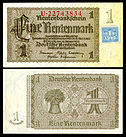East German Mark
| East German mark | |||||
|---|---|---|---|---|---|
| Mark der DDR (German) | |||||
|
|||||
| ISO 4217 | |||||
| Code | DDM | ||||
| Denominations | |||||
| Subunit | |||||
| 1/100 | Pfennig | ||||
| Plural | Mark | ||||
| Pfennig | Pfennig | ||||
| Symbol | M | ||||
| Pfennig | pf | ||||
| Banknotes | 5 M, 10 M, 20 M, 50 M, 100 M | ||||
| Coins | |||||
| Freq. used | 1 pf, 5 pf, 10 pf, 20 pf, 50 pf, 1 M, 2 M, 5 M | ||||
| Rarely used | 10 M, 20 M | ||||
| Demographics | |||||
| User(s) |
|
||||
| Issuance | |||||
| Central bank | Staatsbank der DDR | ||||
| Valuation | |||||
| Pegged with | Deutsche Mark = (1 DM – 1 M) | ||||
|
This infobox shows the latest status before this currency was rendered obsolete.
|
|||||
The East German mark (German: ![]() Mark der DDR ) commonly called the eastern mark (
Mark der DDR ) commonly called the eastern mark (![]() Ostmark in West Germany and after the reunification), in East Germany only Mark, was the currency of the German Democratic Republic (East Germany). Its ISO 4217 currency code was DDM. The currency was known officially as the Deutsche Mark from 1948 to 1964, Mark der Deutschen Notenbank from 1964 to 1967, and from 1968 to 1990 as the Mark der DDR (Mark of the GDR); it was referred to colloquially as simply the Mark. It was divided into 100 Pfennig (Pf).
Ostmark in West Germany and after the reunification), in East Germany only Mark, was the currency of the German Democratic Republic (East Germany). Its ISO 4217 currency code was DDM. The currency was known officially as the Deutsche Mark from 1948 to 1964, Mark der Deutschen Notenbank from 1964 to 1967, and from 1968 to 1990 as the Mark der DDR (Mark of the GDR); it was referred to colloquially as simply the Mark. It was divided into 100 Pfennig (Pf).
On 18 June 1948 a currency reform was announced for the western zones. Subsequently, on 20 June 1948, the Reichsmark and the Rentenmark were abolished in the western occupation zones and replaced with the Deutsche Mark issued by the Bank deutscher Länder (later the Deutsche Bundesbank). Because the Reichsmark was still legal tender in the Soviet occupation zone, the currency flooded into the east from the west, where it was worthless. This caused sudden inflation, which caused privately held cash in the Soviet zone to become worthless overnight. As an emergency measure, many thousands of employees in the district offices started to affix adhesive coupons to those Reichsmark and Rentenmark banknotes for which the owners could prove their origin, up to a limit of 70 Reichsmark per person. Only such banknotes could be exchanged when the Deutsche Notenbank (the East German counterpart of the Bundesbank) issued the new Deutsche Mark with the subsequent currency reform.
...
Wikipedia


